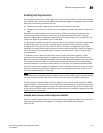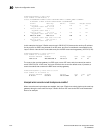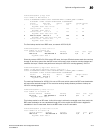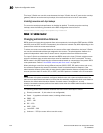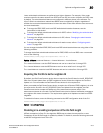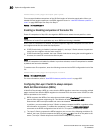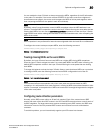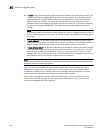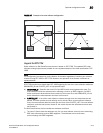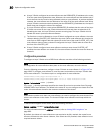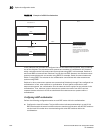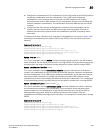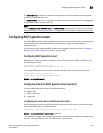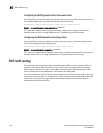
PowerConnect B-Series FCX Configuration Guide 1019
53-1002266-01
Optional configuration tasks
30
FIGURE 147 Example of a route reflector configuration
Support for RFC 2796
Route reflection on Dell PowerConnect devices is based on RFC 2796. This updated RFC helps
eliminate routing loops that are possible in some implementations of the older specification, RFC
1966.
NOTE
The configuration procedure for route reflection is the same regardless of whether your software
release is using RFC 1966 or RFC 2796. However, the operation of the feature is different as
explained below.
RFC 2796 provides more details than RFC 1966 regarding the use of the route reflection attributes,
ORIGINATOR_ID and CLUSTER_LIST, to help prevent loops:
• ORIGINATOR_ID – Specifies the router ID of the BGP4 switch that originated the route. The
route reflector inserts this attribute when reflecting a route to an IBGP neighbor. If a BGP4
switch receives an advertisement that contains its own router ID as the ORIGINATOR_ID, the
switch discards the advertisement and does not forward it.
• CLUSTER_LIST – A list of the route reflection clusters through which the advertisement has
passed. A cluster contains a route reflector and its clients. When a route reflector reflects a
route, the route reflector adds its cluster ID to the front of the CLUSTER_LIST. If a route reflector
receives a route that has its own cluster ID, the switch discards the advertisement and does
not forward it.
The Dell PowerConnect device handles the attributes as follows:
• The Layer 3 Switch adds the attributes only if it is a route reflector, and only when advertising
IBGP route information to other IBGP neighbors. The attributes are not used when
communicating with EBGP neighbors.
Route
Reflector 1
Route
Reflector 2
Route
Reflector
Client 1
Route
Reflector
Client 2
EBGP
IBGP
IBGP
IBGP
AS 1
AS 2
Cluster 1
10.0.1.0
10.0.2.0
Switch
Switch
Switch



